Qiangdi: a popular musical instrument that Xuanzong of Tang Dynasty was chanting at his deathbed.
Editor’s note:Qiangdi is one of the most common images in Tang poetry, and it is also an important cultural symbol of the communication and integration of all ethnic groups in history. Ma Rong wrote in Flute Fu: "In modern times, the double flute started from Qiang, but the Qiang people did not cut bamboo"; Wang Zhihuan’s "Liangzhou Ci": "Why should the Qiangdi blame the willow, the spring breeze does not pass Yumenguan". The ethnic memory and cultural tradition of Qiangdi are deeply engraved in the cultural history of the Chinese nation. It is a musical instrument for rejoicing and rejuvenating, and it is also a witness of ethnic blending.
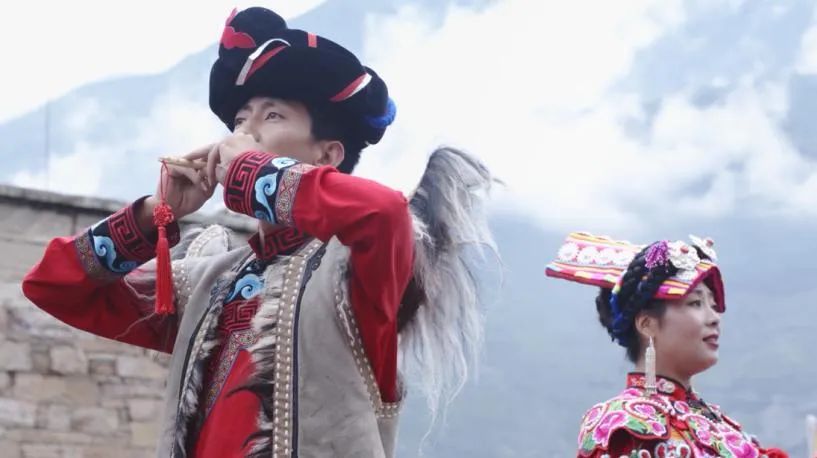
▲ Qiang flute playing. Qiangdi is an ancient single-reed musical instrument in China. Legend has it that it was invented by Qiang people who wandered in the northwest plateau during the Qin and Han Dynasties, and it has a history of more than 2,000 years. Today, the Qiang flute, which is popular in the Qiang people’s residential area of Aba Tibetan and Qiang Autonomous Prefecture in northern Sichuan, is mainly used for solo. There are more than ten ancient tunes with a wide range of music contents, which mainly convey the yearning of the Qiang people. On May 20th, 2006, the performance and production skills of Qiangdi were approved by the State Council and included in the first batch of national intangible cultural heritage list. (Source: Tencent)
How popular was Qiangdi in the Tang Dynasty? Ye Tingxuan’s "Sea Records Broken Things" records that Xuanzong of the Tang Dynasty was on the verge of collapse, and specially instructed the courtiers to give the purple Yu Di that they often played to Daizong. Lu Zhao’s "Yi Shi" said that people in Yuezhou (Shaoxing City, Zhejiang Province) paid a lot of money to hire Li Mo, the first flute player, to play from Chang ‘an, the capital of the capital. After Li Mo arrived in Yuezhou, it caused a sensation, and local prominent people paid a lot of money to listen to him play the flute. Li Qi’s Ancient Meaning, Li Bai’s Listening to Han Shi’s Imperial Flute in Jinling, Du Fu’s Boating in the West of the City, Cen Can’s a Song of White Snow in Farewell to Field-Clerk Wu Going Home, etc., often write stories about the Tang people’s pleasure in the Qiang flute, so that Mr. Lin Geng praised the Tang poetry in the article "The vitality and new essence of poetry" that "as long as you meet the flute, it seems that you will never become a good sentence". It can be seen that Qiangdi is popular with the Tang people.
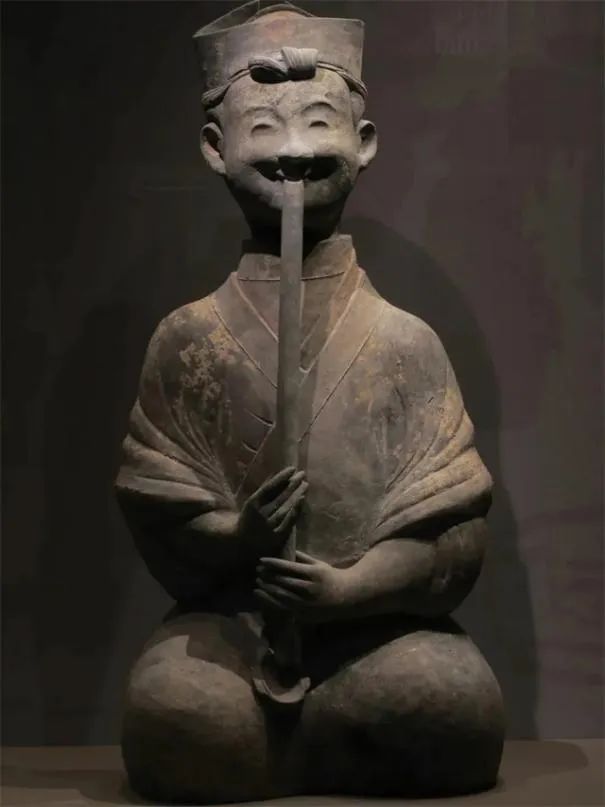
▲ Eastern Han pottery flute figurines. In Han Dynasty, the distinction between flute and Xiao was not obvious. Xiao was called "Shu", also known as "vertical Shu". It was not until the Tang Dynasty that the flute with six holes and bamboo film began to appear, and the flute was officially separated. Today, our common saying "playing flute horizontally and flute vertically" began in the Tang Dynasty. The Song Dynasty’s "Zhu Xi’s Quotations" also recorded: "The person who plays the flute today is the ancient flute, but the flute is the ancient flute." (Source: Chengdu Museum)
Qiangdi was popular in the Tang Dynasty, but it was not introduced into the hinterland of the Central Plains in the Tang Dynasty. When Qiangdi was introduced into the Central Plains is unknown in history. However, Ma Rong’s "Flute Fu" said that Qiu Zhong in the period of Emperor Wu of the Han Dynasty knew the source of the flute, and quoted him as saying that "the modern double flute started from Qiang". In addition, Ying Shao’s Custom Tongyi and Xu Shen’s Shuowen Jiezi mentioned Qiangdi, Song Shu said that there was a record of Zheng Di in the Han Dynasty, and the Book of the Later Han Dynasty recorded that Emperor Ling of Han was fond of Hu Di, which was followed by nobles. It can be seen that Qiangdi should be introduced into the Central Plains in the Han Dynasty. It may have been introduced when Emperor Wu of the Han Dynasty opened up Longyou and the Western Regions. These two places are the main settlements of the Qiang people. After Emperor Wu of the Han Dynasty opened Longyou and the Western Regions, a large number of exotic foreign bodies such as wine, bloody BMW, and the illusion of Manyan fish and dragons began to flood into the hinterland of the Central Plains. As a treasure of Qiang culture, Qiang flute was probably introduced to the Central Plains at this time.
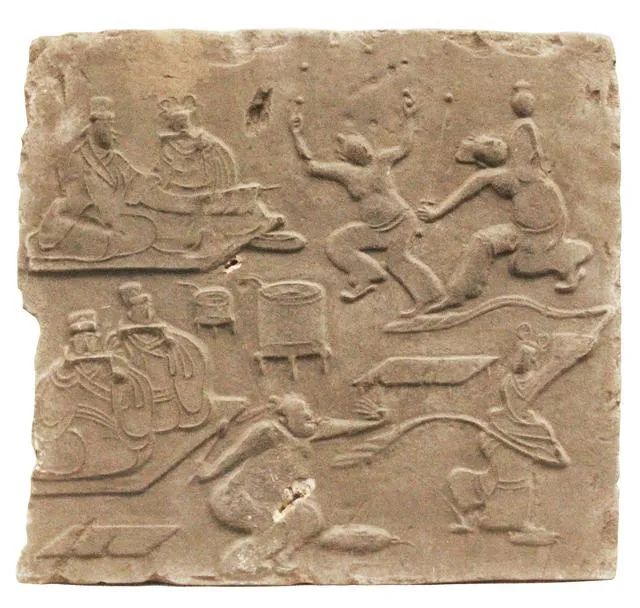
▲ Picture brick of Maruko Banquet Dance in Han Dynasty, unearthed in Anren, Dayi in 1972, collected in Sichuan Museum.
After the Qiang flute was introduced into the Central Plains, it was transformed by musicians, and its shape changed from three holes to four holes, five holes, six holes, seven holes, and so on. The materials and lengths of the flute tubes were varied. People also call it the flute, the flute, the Yu Di, the twelve-rhythm flute, the transverse flute, etc. Only Chen Yang’s Le Shu records 17 different flute names. At the same time, the Qiang flute has become the tradition of China flute. Although there are many opinions about the origin of China’s flute in academic circles, up to now, the article "Qiangdi" in Duan Yucai’s Notes on Shuowen Jiezi says that "both flute and Qiangdi originated from Qiang, and Han Qiuzhong did it because Qiang people cut bamboo, so it is still reliable". Poets in the Han and Tang Dynasties often mix the flute with the Qiang flute, such as Li Bai’s "Smelling the Flute in Qingxi at Midnight" and Gao Shi’s "Listening to the Flute on the Plug", etc., with the title of writing the flute, but actually chanting the Qiang flute; Lu Yanji notes that "the flute starts in Qiang" in the Northern Expedition of General Yong Huo. Duan An Festival’s Yuefu Miscellany says: "The flute player is also a strong musician". In the Tang Dynasty, an anonymous writer, Di Fu, said that the flute "Jue Cao originated from the Qiang head". Therefore, we have reason to believe that Qiangdi is the source of China’s flute, and the flute mentioned by poets in Han and Tang Dynasties is Qiangdi.
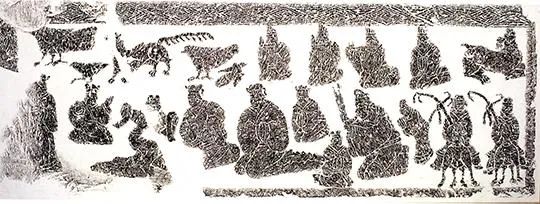
▲ The "Music and Dance Map" stone relief unearthed from the Han stone relief tomb in Miaoshan, Xuzhou. On the left of the long-sleeved dancer in the picture, there is a man sitting on the ground, clapping his hands and singing. On the right of the dancer, there is a man playing the piano, and there are accompaniment players such as flute player, flute player and flute player behind him. (Source: Xuzhou Museum official website)
The change of shape has enhanced the expressive force of Qiangdi and rapidly promoted its musical status. As early as the Wei and Jin Dynasties, Qiangdi became a harmonious musical instrument for temples and banquets. The Book of Jin said: "On the banquet hall, there is a bell hanging without a box, and the flute has a certain tune, so all the string songs are correct from the flute." Qiangdi was widely used by Wei Jin people for "miscellaneous quotation, harmony of various songs", gradually entered the daily life of literati, became their entertainment program, and also became an important theme of their creation, resulting in many masterpieces such as Ma Rong’s Flute Fu, Li You’s Ming of Flute, Cao Pi’s Good Deeds and so on. In the Northern and Southern Dynasties, poets wrote the Qiang flute into frontier poems, such as Dai Hao’s "Join the Army", "The Qiang flute hisses in the pipe" and Zhang Zhengjian’s "Longtoushui", and the Qiang flute has become a cultural symbol for poets to show their customs beyond the Great Wall.
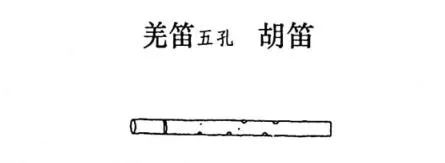
In the Tang Dynasty, people’s love for Qiangdi was unprecedented. There are four main reasons:
First, the pithy and moving flute sound. In the Tang Dynasty, the Qiang flute was mainly composed of five holes and seven holes. The article "flute" in Tongdian Lesi says: "Today, the flute is used to snap. Those who add it are called righteous flutes. " Chen Yun’s "Le Shu" recorded the meaning of the flute as follows:

And in the picture, it is explained that "the righteous flute is like a horizontal flute, and it is added, and the west beam is also happy." Tang Dynasty’s "The Flute Sounds Like a Long Yin Fu" said that the flute "has four holes and five tones". It can be seen that there were indeed five-hole Qiang flutes in the Tang Dynasty. Shan Li’s annotation of Flute Fu said: "Flute has seven holes. One foot four inches long. Today’s flute is also. " It can be seen that the seven-hole Qiangdi also spread to the Tang Dynasty. The number of holes and the length of flutes of these two kinds of Qiangdi exceed the original three-hole Qiangdi, and their expressive force is more prominent, which can blow out a variety of pithy and moving flutes.
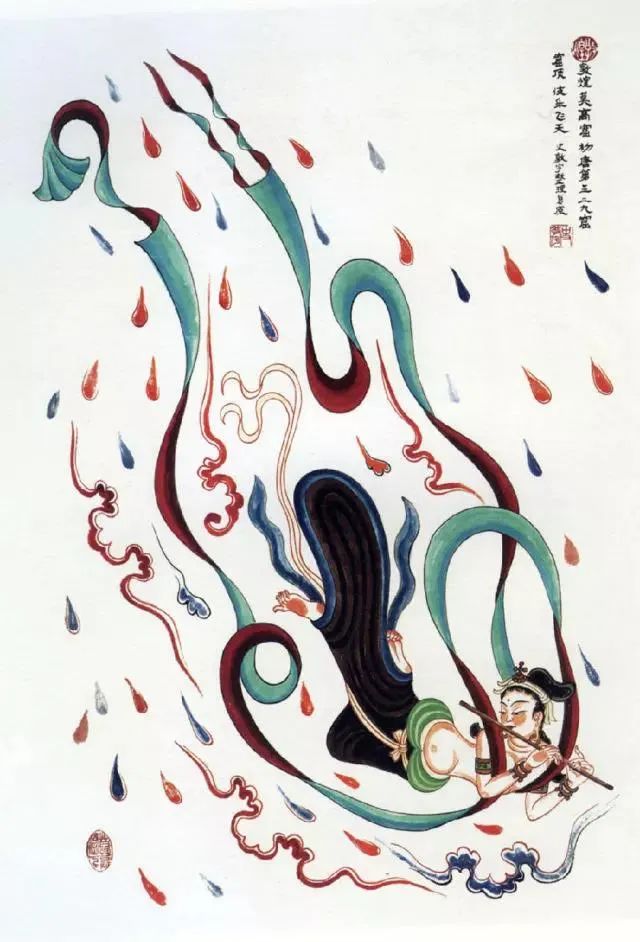
▲ The Mogao Grottoes played flute in Cave 329 in the early Tang Dynasty. In the picture, the geisha music flies in the sky and plays the flute, with a graceful posture and agility. (Source: Netease)
For example, the voice of Qingyue Yifa. Li Zhao’s Supplement to the History of the Tang Dynasty said: "Li Zhou did a good thing, tasted the smoke and bamboo in the village, cut it off as a flute, and it was as hard as stone to leave Li Mou. The flute is the best in the world, and the river is flooded on a moonlit night. The Weizhou blows it, and Liao Liang escapes and goes to Yun Biao. " Lu Zhao’s "Yi Shi" records that Yuezhou literati praised Li Mo’s flute as "it is better to be happy in the sky than in the sky". The words "Liao Liang’s Qing Yue", "Liao Liang’s Yi Fa" and "Jun Tian’s Joy" indicate that Qiangdi can emit the general Yi Yun of Yue Xian. The royal family in Li Tang worships Laozi as the ancestor, worships Taoism, and cultivates Taoist aesthetic psychology with nothingness, indifference and adaptability as its beauty. This kind of escape rhyme of Qiangdi is in line with the aesthetic standards formed by the Tang people based on Taoist philosophy, thus winning their favor.
For example, the sound of weeping and resentment. Hu Zhenheng’s "Tang Yin Gui Qian" said: "Xuanzong was lucky in Shu and went to Luogu, which was called Gao Lishi: ‘ I don’t need Zhang Jiuling’s words, so far. ’ Play a tune on the flute and shed tears. Later, the company recorded it into music, and asked for the title of the song, saying: ‘ Because I think about nine years old, I can call this song "Death of Immortal Hatred". ’ Its sound is bitter, and all the songs are Moby. " Li Bai’s "Watching Hu People Play the Flute": "Hu people play Yu Di, half of which is Qin sound. In October, Wu Shanxiao, plum blossoms fall into the pavilion. When I smell the saiqu, I am full of tears. But I look at Chang’ an Road and miss the main feelings. " Whether it is a high-ranking official, even the supreme Emperor Xuanzong of the Tang Dynasty, or Wang Changling, Li Bai, Du Fu and other literati, as well as ordinary people, they are inevitably frustrated in their lives. The wailing sound of Qiangdi often becomes a good medicine to heal their broken hearts, so they generally like Qiangdi.
For example, the sound of joy is sparse. Wang Wei’s "Liangzhou Competition God" wrote that the athletes outside Liangzhou played the rushing and joyful Qiang flute to enhance the atmosphere of the game; Li Bai’s "Leave a gift to Cui Xuancheng after the chaos" said that Cui Qin often sat on the Hu bed and played the purple Yu Di to entertain him, and the flute resounded through the sky, making him extremely happy and entertaining. Cen Can’s "a Song of White Snow in Farewell to Field-Clerk Wu Going Home" and "but we drink to our guest bound home from camp, and play him barbarian lutes, guitars, harps" convey the rapid and cheerful sound of the Qiang flute. It can be seen that the joyful and bright sound of Qiang flute is also an indispensable program for Tang people to feast and entertain.
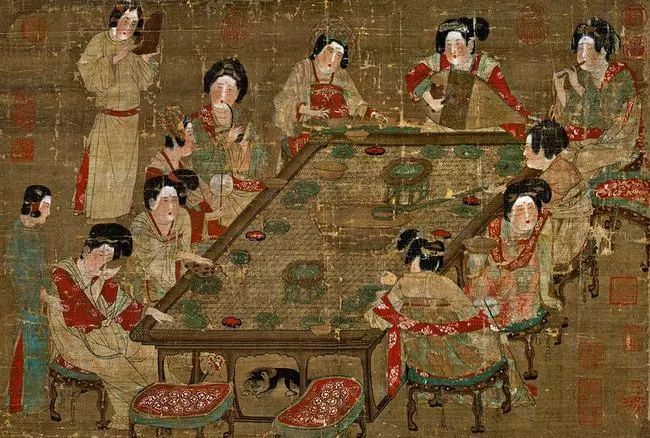
▲ "Tang Palace Music Map". This picture is a silk ink painting created by an anonymous person in the Tang Dynasty, which is now in the National Palace Museum in Taipei. The picture depicts a group of women in the palace feasting and having fun around the console table, and the women are playing and drinking happily. (Image from the Internet)
Second, rich and touching flute music. Hu Zhenheng’s Tangyin Guiqian said that the repertoire of Qiangdi was "the same as that of those who played the flute, flute and flute." There are more than forty songs, such as hentai and Happy Tree. See the Prelude ". In addition to these ancient songs, the Tang people also created many touching flute songs, such as "Death of Immortal Complaints", "Alandui", "Litchi Songs" and "Six Weeks". The expressive Qiang flute plays these heart-warming flute tunes, and when the Tang people listen to them, they are often "full of salt and shock, and the doubt is suddenly in the field." When you are sad and clear, you will forget your worries; Imagine that things are like clouds, which makes them linger and put it down.
Third, powerful people love Qiangdi. The royal family of Li Tang is imbued with the blood of the northern minorities, and pursues the ethnic policy of Hu Han’s family. They have an open and inclusive attitude towards foreign bodies. Especially between Kaiyuan and Tianbao, Emperor Xuanzong of the Tang Dynasty knew the melody and loved the Qiang flute. He was not only good at playing the Qiang flute, but also knew the flute rhythm and created many touching flute music. Under their influence, nobles, nobles, citizens and ordinary people generally like Qiangdi. For example, Wei Chiluo’s "The Story of China and North Korea" said: "There are many birds in Mount Li, and it is called Alandui. The Ming emperor imperial Yu Di, adopted its voice and translated it into a song, which was sung by both sides. It is broadcast far and near, and people compete to play with the flute effect. " "Tai Ping Guang Ji" records that Emperor Xuanzong of Tang Dynasty especially liked Hu Xiao, a disciple of Liyuan who was good at playing the Qiang flute. Hu Xiao was arrested for committing a crime, and Tang Xuanzong specially ordered him to be released. As the saying goes, it is necessary to be good in the world. Driven by the powerful people represented by Emperor Xuanzong of the Tang Dynasty, Qiangdi attracted the attention of the Tang people, and its prosperity was unprecedented.
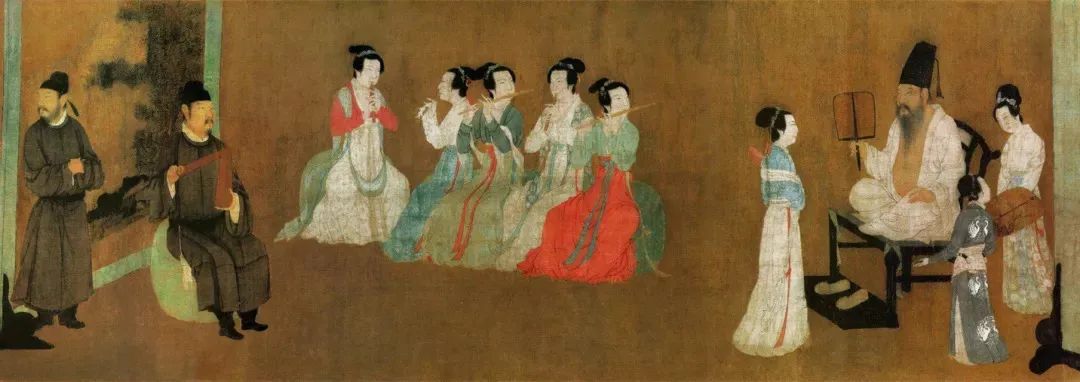
▲ "Han Xizai Night Banquet" part. The Picture of Han Xizai’s Banquet was painted by Gu Hongzhong in the Southern Tang Dynasty. The existing copy of the Song Dynasty and the silk version are colored, and are now in the Palace Museum in Beijing. The above picture shows the ensemble of wind music. In the picture, five musicians sit in a row horizontally, each with its own dynamics. Although they are in the same row, there is no sense of stagnation. (Image from the Internet)
Fourth, the promotion of teaching workshop institutions. Cui Lingqin’s "Jiaofang Ji" records that both Xijing Chang ‘an and Tokyo Luoyang set up special music institutions in the Tang Dynasty — — Jiaofang The teaching workshop is divided into two parts: left and right. According to the textual research of Ren Bantang’s Notes on Jiaofang, "In addition to the left and right Jiaofang in Xijing, there are also Jiaofang in Zhannei, which belongs to the Propaganda Department and is in Xuanping Square". Handsome civilians can be selected to teach songs and dances, musical instruments and so on. Qiangdi is one of the courses in Jiaofang. The teaching workshops in the Tang Dynasty were very large in scale. Although they were not all responsible for practicing Qiangdi, there should be a large number of them. People in the Tang Dynasty lived in Chang ‘an, and at night they often heard musicians practicing their flutes. For example, Wang Shu’s "Tang Yu Lin" said, "Wang Zhen is too often Qing. Early in the morning, I heard the people in Yongxing playing the flute and asked: ‘ Are you too happy? ’ Yue: ‘ However ’ " . It is self-evident that the establishment of Jiaofang has played an important role in the spread of Qiangdi. What’s more, the musicians in the workshop can take time to perform outside the workshop, such as Li Mo playing flute in Yuezhou and Guazhou, which is more conducive to the spread of Qiangdi. After the Anshi Rebellion broke out, the musicians in Jiaofang were either taken to the north or wandered around, and the Qiang flute spread all over the Central Plains with their footsteps.
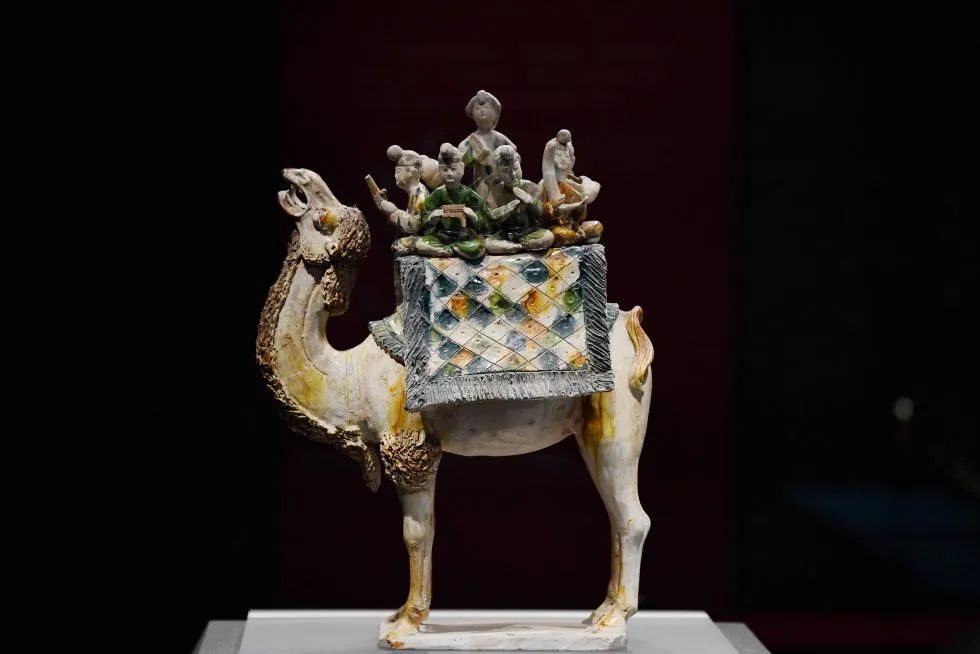
▲ Tang Tri-colored Camels carrying musical figurines were unearthed in the Tang Tomb of Zhongbao Village in the western suburbs of Xi ‘an, Shaanxi Province in 1959, and are now in the Shaanxi History Museum. In the picture, seven male musical figures are holding sheng, pipa, flute, clapper, harp, flute and Xiao respectively, with a woman singing and dancing in the middle. The figurine is novel in shape and lifelike in image, and is known as the masterpiece of tri-colored figurines in Tang Dynasty. (Source: Xinhua News Agency)
To sum up, the change of shape has given Qiangdi a stronger expressive force, making it have a bright and pithy sound quality, and playing many refreshing, sad and glamorous flute music; In addition, the powerful and noble people loved the Qiangdi and the promotion of teaching workshops. Qiangdi successfully captured the favor of the Tang people and was deeply embedded in their daily life and spiritual world. Literati engaged in literary activities by appreciating, hearing and writing Qiangdi, which was very active in the Tang Dynasty. The reaction of literature has accelerated the spread of Qiangdi. In the end, Qiangdi became one of the best popular musical instruments in the Tang Dynasty and successfully integrated into the splendid cultural river of the Tang Dynasty.

About the author:
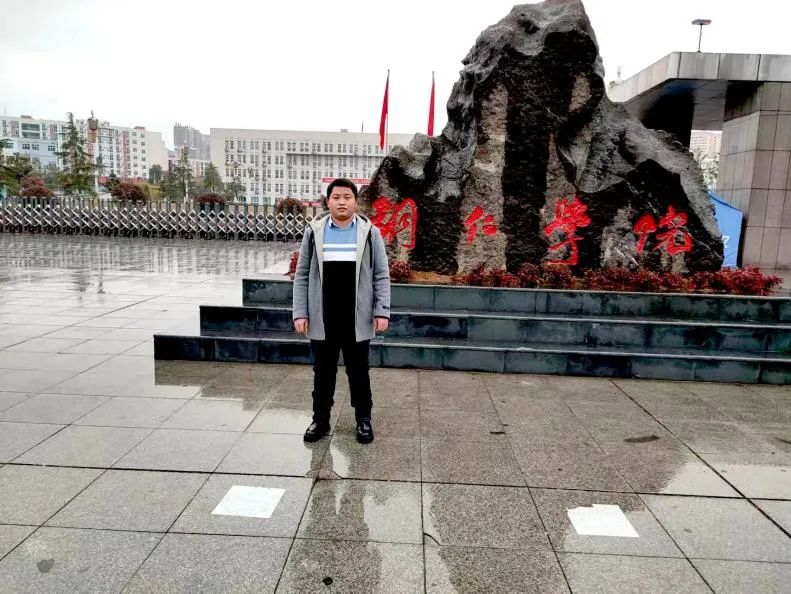
Long Zhenghua, Doctor of Literature, Xiamen University, is a young teacher in the School of Humanities, Tongren University. His main research field is China ancient literature.
Producer | Yang Xinhua
Coordinating | Kang Kunquan, Hu Jun, Liu Jia
Writing | Chen Hailong
Editor | Guo Hui
Production | Hu Qi